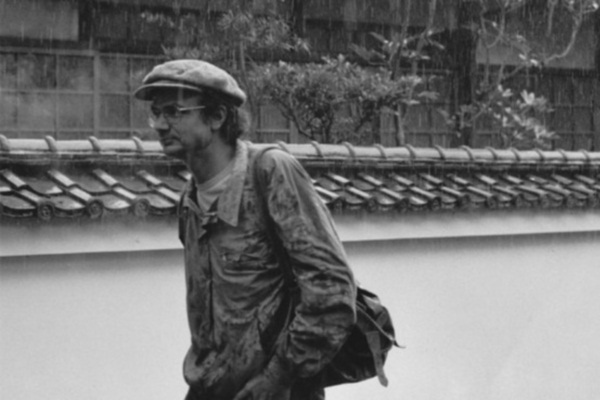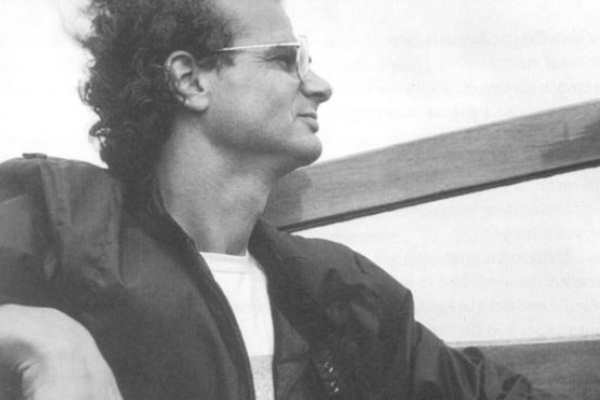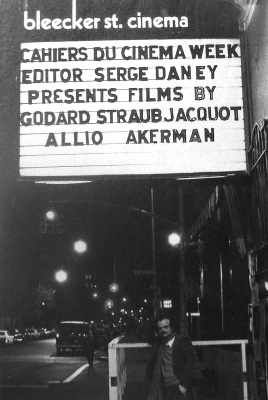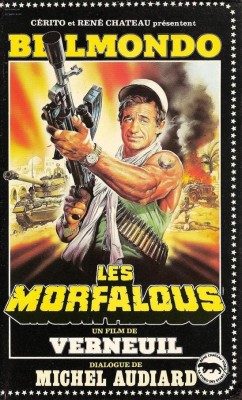The Smuggler
It’s been two decades since the French film critic Serge Daney died from AIDS-related causes, leaving behind thousands of reviews and essays, as well as articles on television, movies-on-television, politics, art, travel, photography, ping-pong, TV news, and, last but not least, tennis—a sport he wrote about with both the expertise of an ardent fan and the eye of a cinephile who found it the perfect metaphor for the moviegoing experience. During a projection, the viewer and the film rally back and forth, and the question then becomes “at what point do we stay on this side of the net, at what point does the mise-en-scène take us by the hand and give us the right to step over the net or to make a passing shot?”1

Serge Daney
A month after his death, the Cahiers du cinéma—where Daney worked between 1964 and 1981, first as a critic and then as editor in chief along with Serge Toubiana—dedicated a special summer issue to the late critic, gathering together dozens of testimonies from some of France’s leading intellectuals and filmmakers, and publishing the full transcript of Daney’s final public appearance at the Jeu de Paume in Paris in May 1992.
During the two-hour talk organized to launch the second issue of Trafic, the review Daney founded a year earlier with Cahiers alumnus and cineaste Jean-Claude Biette—he spoke in his famously freewheeling, passionate yet utterly precise and poignant manner about everything from Giotto to Godard to The Godfather: Part III (his favorite in the trilogy) to the superiority of Boyz n the Hood to Do the Right Thing (“I find that Spike Lee...is putting himself in service of a cause that’s stronger than he is and that he doesn’t profoundly adhere to.”2) At one point, during a discussion of the merits of Jacques Doillon versus the demerits of Jean-Jacques Annaud (one of his favorite directorial punching bags), he said something that perhaps best sums up his approach to film criticism: “Cinema is not about quality, it’s about morality, it’s about ethics.”3
Indeed, if there’s one long, unwavering line—call it the baseline—that traverses Daney’s colossal oeuvre, making him the most direct heir to André Bazin and the critic-filmmakers (Godard, Truffaut, Rohmer, Rivette, and Chabrol) of the Cahiers jaunes, it’s this moral and ethical stance, this desire to regard cinema as a profoundly humanistic experience and to hold filmmakers responsible for the choices they make on screen.
The line stretches all the way back to when Daney was 16 years old and first read Rivette’s much-quoted Cahiers review of Gillo Pontecorvo’s Kapò (1960), in which he wrote that the person (i.e., the director or cameraman) who chose to track in on—and unduly aestheticize—the suicide of a concentration camp prisoner “deserved nothing but the most profound contempt.”4 As Daney explains in his posthumously published cine-biography, Persévérance (translated into English by Paul Grant as Postcards From the Cinema):
If I didn't apply the axiom of the “tracking shot in Kapò” only to films that were exposed to abjection by their subject, it was because I was tempted to apply it to every film. “There are things,” wrote Rivette, “that must be approached with fear and trembling. Death is undoubtedly such a thing, and how does one, at the moment of filming such a mysterious thing, avoid feeling like an impostor?” I agreed.5
As later revealed in the lengthy interview—conducted by Toubiana and extensively rewritten by Daney—that comprises the two other sections of Persévérance, the focus on Kapò was by no means a coincidence.
Born in the Bastille section of Paris only a few days before D-Day, Daney was raised by a working-class single mother, to whom he remained closely tied throughout his life, eventually settling on the Rue Traversière just a few blocks from her apartment. With little means to get out of the neighborhood, the young Serge turned to the local movie theaters as his main source of entertainment, and his growing passion was boosted by his encounter at the Lycée Voltaire with fellow cinephiles Louis Skorecki and Claude Dépêche, with whom he founded a short-lived review called Visages du Cinéma.

Serge Daney
It was also at Voltaire that Daney’s French teacher, Henri Agel, first screened Alain Resnais’s Night and Fog for his students, and the shock of seeing that film, along with Hiroshima, mon amour and the reading of the Kapò text, would form the backbone of Daney’s future writings. A backbone at once moral and deeply personal, because as Daney recounts early on in Persévérance, the father he never knew was, per family legend, a Viennese Jew named Pierre Smolensky, a man of many hats—entrepreneur, world traveler, film dubbing actor—who was arrested by the French police toward the end of the war and was never heard from again.6 7
For Daney, postwar cinema, which is to say modern cinema, would thus be inexorably linked to childhood—both his own and, more generally, to the childhood experience—which is why he would return time and again to two very different kinds of “kids’ movies”—Fritz Lang’s Moonfleet and Charles Laughton’s The Night of the Hunter—as examples of how films, like fathers, can guide us into the world:
I know of few expressions more beautiful than Jean-Louis Schefer’s in L'homme ordinaire du cinéma when he speaks of “the films that have watched our childhood.” It’s one thing to learn to watch movies “professionally”—only to verify that movies watch us less and less—but it is another to live with those movies that watched us grow up and saw us—prematurely hostage to our coming biographies—already entangled in the snare of our history.8
With an ethical approach to mise-en-scène and an autobiographical vision of film/film history forming the crux of his critical bias—one further fueled by the writings of Barthes, Debord, Deleuze, and especially Lacan—Daney eventually set his sights on what would become his greatest theoretical legacy, which traverses many of his later articles, reviews, and interviews: the differentiation between the image and the visual.
Partly because of a debilitating health situation that forced him to spend increasing amounts of time at home, Daney began writing more and more about television for Libération–the French daily where he served as chief film critic and then culture editor from 1981 through 1991—maintaining a column he called “Le Salaire du zappeur” (“The Salary of the Channel Surfer”) where he discussed commercials, music videos, talk shows, tennis matches, Dallas, Max Headroom, and most importantly, the Persian Gulf War.
It was while watching the nonstop coverage—or lack thereof—of the war that Daney openly reflected on the preponderance of what he called the visual:
To risk going quickly, the visual (which is the essence of TV) is the spectacle that one side offers up to itself while the image (which was the horizon of the cinema) is that which is born from an encounter with the other, even if it’s the enemy.9
In a Libération editorial entitled “The Visual Offensive,” he added:
Retreat, everywhere, of the image. Offensive, everywhere, of the visual (I remind you that the “visual” is this domain of perception where I no longer risk encountering the other, whoever it may be).10
The failure of TV news to offer up a single image of the war—a sentiment echoed in Jean Baudrillard’s book-length essay, The Gulf War Did Not Take Place—was representative of the greater failure of movies, in a cycle beginning in the ’70s and literally exploding in the ’80s and early ’90s, to provide nothing but visuals to the viewer. The films of hotshot French directors of the epoch like Annaud, Jean-Jacques Beineix, and Luc Besson, pioneers of a new Nouvelle Vague rooted in advertising and excess, as well as Hollywood blockbusters like Jaws and Tron, provided mounting evidence that images, as defined by Daney, were becoming extremely hard to come by.
If cinema is an art based in images, then their growing absence from the screen was evidence of the medium’s decline, and Daney began forecasting the death of cinema nearly a decade before his own. He saw his life as synchronous with “the 30 glorious years of modern cinema”11 that kicked off with Rossellini’s Rome, Open City (1945) and then began dipping south with such swan songs as Wim Wenders’s The State of Things (1982), until crashing and burning with the CNN coverage of the Gulf War and movies like Annaud’s The Lover (1992)—a critical darling Daney felt turned the viewer into a mindless consumer, a film in which the “chances of an accidental encounter with reality are remote indeed.”12
As Daney memorably remarked in a 1991 interview with Philippe Roger, “If you can’t believe just a little in what you’re seeing on the screen, there’s no point in wasting your time on cinema,”13 and the abundance of visuals both at the movies and on TV was a sign that the cinema—the kind that beckoned you to leap over the net—wouldn’t necessarily survive him.
***
Twenty years on, where exactly does Daney stand? Suffice to say that in France, his legacy is very much intact, with any one of a dozen editions of his writings available at your local bookstore, the most recent being the third volume of publisher P.O.L.’s gargantuan collection of articles, La Maison cinéma et le monde 3: Les années Libé 2, 1986-1991.
A glimpse inside the 880-page book reveals Daney’s staggering output throughout his final years at Libération, during which he often averaged two to three articles a day on a wide range of subjects—the Khmer Rouge, the Davis Cup, and the Salman Rushdie fatwa, to name a few—alongside hundreds of movie reviews, essays, and chronicles of film festivals from Carthage to Cannes (a festival he could be particularly prickly about: a 1987 article mocking jury president Yves Montand’s press conference earned him the wrath of the actor, who publicly threatened to “kick his ass.”14 Daney was not one to mince words, and occasionally provoked the furor of local film industry stalwarts).15
During a daylong conference this June at the Cinémathèque Française to commemorate the 20th anniversary of Daney’s death, there was further evidence of his vast impact on French film and film criticism. Among the speakers were a number of critics and journalists who began their careers with Daney, including Toubiana (who now runs the Cinémathèque), former Cahiers editor-in-chief Charles Tesson (who now runs the Cannes Critics’ Week sidebar; meanwhile, Edouard Waintrop, who worked for Daney at Libération, now runs the Directors’ Fortnight), Libé film journalist Olivier Séguret (the first critic in France to discuss the impact of video games on visual culture), and Trafic editorial board member Patrice Rollet (who has so far edited the three P.O.L. collections and is virtually a one-man Daney machine).
Behind the camera, Daney’s reach is perhaps even more impressive. Filmmakers Olivier Assayas and Claire Denis both spoke at the conference about his influence on their work—Assayas as a young critic hired by Daney to write for Cahiers, Denis as the director of a 1990 documentary on Jacques Rivette (Jacques Rivette, Le Veilleur) that featured an extended dialogue between Daney and the New Wave cineaste (completely dominated, according to Denis, by the inexhaustibly talkative Daney—to the point that the only way to leave any room for Rivette, the actual subject of the movie, was to shoot for an entire night on the rooftop of Libération, waiting until Daney tired out and finally allowed Rivette to get a few words in).
Beyond Assayas and Denis, there are also those onetime enfant terribles whose first films Daney championed: Leos Carax and later, Arnaud Desplechin (both of whom sat in as students on Daney’s freeform lectures at Censier University-Paris III), as well as actor-director Xavier Beauvois (who met Daney when he was 18 and later wrote: “No need to go to La Fémis16 when you can have dinner with Serge Daney”17). And then there are the many filmmakers whose work evolved alongside, and was accompanied by, his writings: Philippe Garrel, Jean Eustache, Jean-Marie Straub and Danièle Huillet, and of course Jean-Luc Godard, whose view of cinema as an art that would live and die with the 20th century very much coincides with Daney’s vision. (A dialogue between Godard and Daney is featured in Episode 2A of the Histoire(s) du Cinéma, while Daney is also included in a chronological montage of French thinkers—including Diderot and Bazin—toward the end of Godard and Anne-Marie Miéville’s 2 X 50 Years of French Cinema [1995].)

Serge Daney
So while it’s safe to say that Daney remains the critical voice to reckon with in France—a voice so expansive and unbeatable that several young critics at the Cinémathèque conference mentioned how daunting it was to write après Daney—the same cannot be said for the English-speaking world18, where thus far only one of his books has been published (Grant’s excellent Persévérance translation), along with a few articles that have popped up in film magazines (Film Comment and Sight & Sound) or on websites (Senses of Cinema and the now defunct Rouge). As for academia, courses in film criticism or post-critical thinking are likely to include such Daney contemporaries as Deleuze, Baudrillard, Jacques Rancière, Paul Virilio, and Raymond Bellour, but nothing by the man himself.
If there is one place where Daney has found some traction in English, it’s in the blogosphere, where various translations—some commissioned, some voluntary—can be readily accessed at sites like New York critic Steve Erickson’s Chronicle of a Passion (not a blog per se, but a one-man show all the same) and Laurent Kretzschamer’s Serge Daney in English, both passion projects looking to smuggle some Daney across the Atlantic. The word “smuggle” is a vital one, as Daney often referred to himself as a passeur19 in his final years:
A passeur is perhaps someone who remembers true communication, the kind that left a mark on their lives, not the kind imposed upon them (by school, catechism, advertising—all that which is “enriching”) but the kind carried out almost furtively, transversally and anonymously. The more one gets to know their public, the more they become of service to them. And then one no longer “passes” anything—one becomes a sifter, which is another job (which, incidentally, “pays” much better).20
While the overall anglais situation has hardly improved much since Jonathan Rosenbaum called for a Daney revolution over a decade ago, there’s something ironic in the fact that his writings have become a form of cinephile contraband, e-mailed back and forth by eager newcomers or translated free of charge by devotees hoping to spread the word. Perhaps he would have preferred it as such, and as his former Cahiers colleague Alain Bergala remarked at the conference, Daney’s ideas were never meant to be solidified into an official doctrine, but were more of a perpetual reaction to the present expressed through conversations and print journalism—two mediums with somewhat ephemeral lifespans. (“What’s beautiful about a newspaper,” Daney remarked, “is that, as the saying goes, ‘it’s useful for wrapping up fish.’”21)
Still, it’s unfortunate that at a time when the visual has pretty much smashed (to use another tennis metaphor) the image off both the big and small screens, many Anglo-American critics, scholars, and filmmakers are not familiar enough with his theories, which continue to provide some of the sturdiest tools for chipping away at the current media edifice. Meanwhile, those well versed in his work are likely to perform a continual W.W.D.D. (swapping Daney for Dexter), applying his concept of the image vs. the visual, as well as his discussions of the shot (plan) and montage (his Gulf War essay, “Montage Obligatory,” remains one of the best things ever written about television) to anything from the “embedded” (he would have loved the term) coverage of the War in Iraq to CGI to Snooki, hoping to make sense of a world where constant visual noise, delivered in a multitude of formats, has become the norm.
A special section devoted to Daney in the June issue of Cahiers du cinéma attempts to do just that. In an essay entitled “Daney Today,” current editor in chief Stéphane Delorme offers up an engaging argument as to why Daney matters more than ever, concluding on a pessimistic note with an analysis of the visual in The Hunger Games and the following warning: “Daney’s moral heroism is far from us. It is urgent we reread him closely today.”22 Another essay by Nicholas Azalbert entitled “Has the Visual Become Schizo?” updates Daney’s theories to our era of synthetic imagery, claiming that we have passed from the visual age to the virtual one, in which concepts like mise-en-scène and point of view can no longer exist.23
There’s no question that delving into Daney and the death of cinema/dearth of images is an eye-opening experience. In that light—one now diffused through the murk of DCP projections and LCD screens—some critics may find themselves wondering why they should bother going on at all. If cinema indeed gave up its ghost24 a few decades ago, is there really any point in trying to resuscitate that exquisite 20th century corpse?
Yet Daney was never one to be crushed by dogma—especially not his own—and he constantly revised his thoughts and theories in the deluge of texts and interviews that poured out of him in his final years. He may have seen the end of the kind of films that watched him grow up, but he also saw film as an unfinished art (“The end of a movie is so artificial that you need to write ‘The End’ on the screen in order to convince the viewer”25), and its death more like a long-term malady to adapt to (“In life, it’s not very important to solve problems, but rather to live with them”26). Two films that premiered at Berlin and Cannes this year—Miguel Gomes’s Tabu and Carax’s Holy Motors—provide very different examples of how cinema can be rebooted from its ashes, offering up images infused with the melancholy of their own disappearance.
For the working critic, Daney’s immense output provides further proof that serious film criticism can both challenge and entertain. His writings, especially for Libération, were filled with scores of puns, winks, and witticisms, marked by a razor-sharp voice that quickly rallied the reader to his side, and underscored by the idea that each new film offered up the chance to explore cinema in all its states.
In a 1984 review of Les Morfalous (Henry Verneuil)—a throwaway action-comedy starring Jean-Paul Belmondo that was hardly worth anyone’s time—Daney brilliantly used the film as a springboard for a lengthy reflection on the role of the actor and the auteur, the problem with critic-proof movies (Verneuil had scored several previous box office successes, although this one was something of a flop), and a more general discussion on the critical enterprise, concluding with this statement:
Film criticism hinges on one idea—and one that suddenly seems precarious—which is that between those who manufacture images (and who need to manufacture them) and those who watch them (and who need to watch them), there is a gap, and that this gap is precious. And that it makes sense to interpose a little writing between the film and its public each time they are not exactly face-to-face.27
And then, almost as an afterthought, he reviewed the movie:
P.S. I realize I completely forgot to mention that Les Morfalous is a film without much interest, stiffly directed and adequately rendered. More than ever, it’s enough to look at the poster to know what it consists of. The lack of surprise is guaranteed. Those who like the poster for Les Morfalous will like the film too. The others won’t. The lack of ambiguity is total.28

Les Morfalous, directed by Henri Verneuil
1. Serge Daney, Postcards From the Cinema, Paul Douglas Grant trans. (London and New York: Berg, 2007), p. 141-142.
2. Serge Daney, “Trafic au Jeu de Paume” in Serge Daney (Cahiers du cinéma: Paris, 2005), p. 171.
3. Ibid., p. 150.
4. Jacques Rivette, “On Abjection,” David Phelps trans. Order of the Exile, http://www.jacques-rivette.com (accessed 27/06/12). Originally in Cahiers du cinéma, no. 120, 1961.
5. Serge Daney, Postcards, p. 25.
6. Ibid., p. 44-45.
7. It’s interesting to note that while Daney often wrote about movies involving the Holocaust—up to and including Holocaust, the 1978 TV miniseries starring James Woods and Meryl Streep, about which he remarked “…there would be extras looking a little too fat, good performances, generic humanism, action and melodrama. And we would sympathize” (Postcards, 32)—he never published anything on Claude Lanzmann’s monumental Shoah, which was broadcast on French television for the first time in 1985, precisely when Daney was covering both films and TV for Libération.
8. Serge Daney, Postcards, p. 20-21.
9. Serge Daney, “Regarder (La Guerre du Golfe)” in La Maison cinéma et le monde 3 (Paris: P.O.L., 2012), p. 784.
10. Serge Daney, “L’Offensive du visuel” in La Maison cinéma et le monde 3 (Paris: P.O.L., 2012), p. 794.
11. Serge Daney, Postcards, p. 50.
12. Serge Daney, “Falling Out of Love,” Chronicle of a Passion (accessed 27/06/12). Originally published in English in Sight & Sound, July 1992.
13. Serge Daney, Philippe Roger, “Le Passeur,” in Serge Daney, Devant la recrudescence des vols de sacs à main (1988-1991) (Lyons: Aléas, 1997), p. 92.
14. This story was related during a roundtable at the Cinémathèque featuring several of Daney’s former colleagues from Libération, including journalist and writer Jean Hatzfeld and film critic Olivier Séguret.
15. The most well-known example being L’Affaire “Uranus,” for which Daney’s scathing review of the 1991 Claude Berri film prompted the director to demand Serge July, then editor-in-chief of Libération, the right to publicly respond in the paper’s editorial section—a right granted by July and taken like a slap in the face by Daney, who would leave Libération later that year.
16. The prestigious Parisian film school (formerly known as L’IDHEC), to which Beauvois applied and was rejected.
17. Xavier Beauvois, “Points de suspension,” in Serge Daney (Cahiers du cinéma: Paris, 2005), p. 80.
18. Few translations exist in other languages, although two books—Persévérance and a collection of articles—were published in Dutch last year.
19. Passeur is the French term for a person who helps smuggle someone or something across a frontier.
20. Serge Daney, Philippe Roger, “Le Passeur,” p. 94.
21. Ibid., p. 94.
22. Stéphane Delorme, “Daney aujourd’hui,” Cahiers du cinéma, no. 679, 2012.
23. Nicholas Azalbert, “Le visuel deviant-il schizo,” Cahiers du cinéma, no. 679, 2012.
24. In 1988, Daney started a column in Libération entitled “The Ghosts of the Permanent” (“Les Fantômes du permanent”—a title he borrowed from Jean-Claude Biette) where he reviewed movies seen or re-seen on TV.
25. Serge Daney, Philippe Roger, “Le Passeur,” p. 113.
26. Serge Daney, “Trafic au Jeu de Paume,” p. 157.
27. Serge Daney, “Les Morfalous,” Ciné journal Volume II/1983-1986 (Paris: Cahiers du cinéma, 1998), p. 98-99.
28. Ibid., p. 99. ![]()
LATEST ARTICLES
-20140814-173707-thumb3.jpg)
Fighting Words
by Imogen Sara Smith
posted August 12, 2014

Fighting Words, Part 2
by Imogen Sara Smith
posted August 20, 2014

On the Margins: The Fil…
by Andrew Chan
posted August 12, 2014

Robin Williams: A Sense…
by David Schwartz
posted August 12, 2014
 The Smuggler
The Smuggler
KEYWORDS
film criticism | Serge Daney | cinephilia | Cahiers du cinéma | nouvelle vague | French cinemaTHE AUTHOR
Jordan Mintzer is a film critic for The Hollywood Reporter. Prior to that he worked for Variety. He is the producer of Matt Porterfield's Hamilton and Putty Hill and the author of James Gray (Synecdoche, 2011).
More articles by Jordan Mintzer
